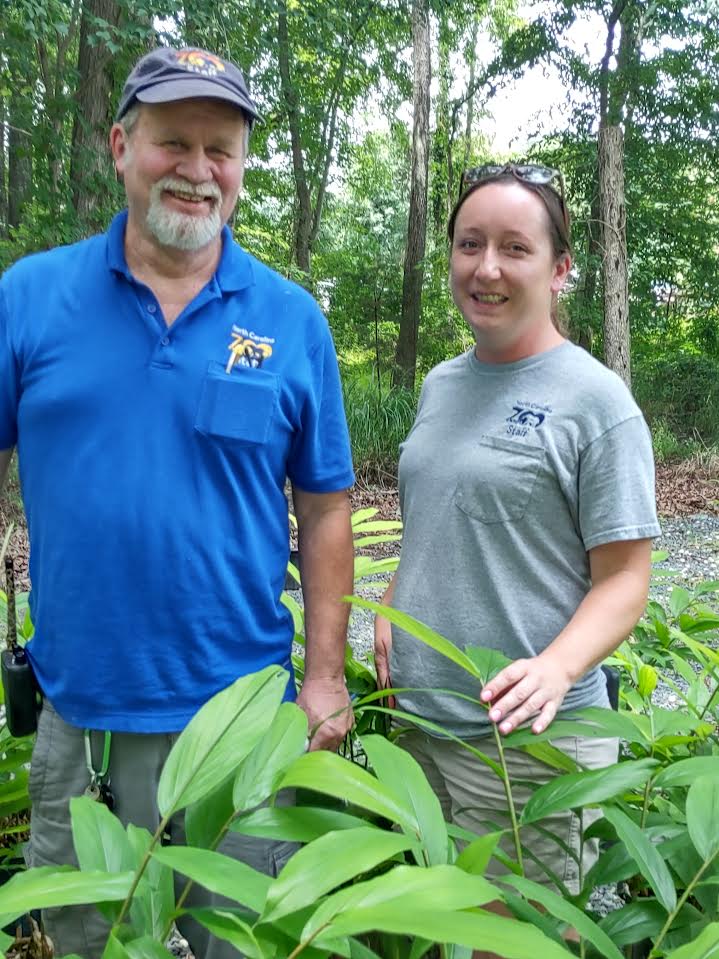Welcome!

Jim Harned and Katie Davis stand amongst Aframomum plants growing outside at the NC Zoo. Photo by Larry Penkava
Grass Native to Africa Added to Zoo's Gorilla Habitat
ASHEBORO — The western lowland gorillas at the North Carolina Zoo are getting a piece of home — Aframomus melegueta.
It’s a plant, a member of the ginger family. Also known as Grains of Paradise, it’s a native of lowland areas of tropical West Africa.
“It’s used as a spice and as a flavoring” by Africans, said Jim Harned, horticulture curator of interior and arbor. In Africa, Aframomum has a use similar to our black pepper.
In addition to its culinary uses, it has been used to lower blood sugar, control diarrhea, as a snake bite treatment, and to control leprosy and measles. Known for its medicinal value, Aframomum is often prescribed for inflammation and infections.
Oh, and it just so happens to be a major component of the diet of western lowland gorillas.
“We started our Aframomum program in 2008 after a trip to Cameroon Africa our curators took,” Harned said. “We started growing it in 2012 and began feeding it from our greenhouse in 2015.”
Katie Davis, interior horticulture supervisor, said Aframomum was a hit with the zoo’s gorilla troop. “They would go right to it initially, almost like an enrichment. They eat the leaves and play with the stems.”
But feeding something new to the animals isn’t taken lightly, Davis said. “We make sure it’s not toxic and run other tests before feeding it. But it does them no good if they don’t eat it.”
Aframomum is a supplement to the gorillas’ diet. They still get their fruits and veggies and protein. Adding a natural African plant, found in their endemic regions, can only be a positive.
It’s not known how much Aframomum affects the overall health of the gorillas. “But It seems that captive gorillas often suffer from an unexplained heart condition and by adding more plants from their native habitats, especially Aframomum melegueta, the condition seems to go away,” Harned said.
Aframomum has been approved as a browse for all mammals, Davis said. “The otters like the scent and rub it on themselves. The problem is it doesn’t grow fast enough, especially in the winter.”
From a one-gallon pot, it takes about a growing season for a plant to grow into a three-gallon pot. Mature plants can get up to six or seven feet tall.
The plants, whose natural enemies are mealy bugs and aphids, are free of pesticides. Instead, the horticulturists use predatory insects such as ladybugs and beetles to keep down the pests.
Currently, the zoo is feeding 16 stalks each day to the gorillas, 20 stalks three days a week to the giraffes and 17 stalks one day a week to the chimpanzees.
In its natural setting, Aframomum is an understory plant that doesn’t like full sun but thrives in hot and humid conditions. The plant is OK during North Carolina summers but must be brought into the greenhouse during the colder months. The minimum temperature is about 65 degrees.
“There’s a debate over inside or outside during the hot months,” said Harned, who favors the greenhouse. However, plants that have been placed outside are taller than those inside. Still, they’ll have to be taken indoors when fall arrives.
The success of the Aframomum program in North Carolina hasn’t gone unnoticed, Harned said. “We’ve had inquiries from other zoos. We could ship to them if they asked.”
Aframomum is even being sold online as an antiinflammatory extract for humans, Davis said. “There needs to be more research on health benefits.”
Meanwhile, the zoo’s horticulture program is growing seven species of Aframomum. “They grow a bit differently, but the animals don’t show any preference,” Davis said. “We’ve been experimenting with different fertilizers and soils.”
They even had a horticulture agent from Cooperative Extension to come out to do soil samples and offer more resources to the program.
Now, five interns from the Randolph Community College Zoo Horticulture Certification Program have been assisting with the Aframomum plants. They help with propagating and seeing how long it takes to grow new plants. The experience is something they can use in their classes.
So what do they see as the future for Aframomum? “Grow more and encourage other zoos to grow it and feed it out,” said Davis.
If growing more Aframomum is the goal, the closure of the Aviary may have at least one positive. “That greenhouse will be converted to a browse Aframomum house,” Harned said.
All in all, he added, “Small plants can have big stories.”
